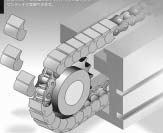Calculation of Chain Tension
On the whole, at first, tentatively decide the chain dimension to be used referring to “Tentative determination of chain size”. Then, receive “Theoretical chain tension (T)” (P213) to the tentatively established chain, and multiply the worth by “Speed coefficient (K)”, to acquire “Substantial chain tension (Ta)”. For safety, the significant chain tension should be reduce compared to the “maximum allowable tension” stated while in the table of dimensions of respective chains. Consequently, the affliction beneath should be happy.
Safety ailment of chain stress
Significant chain stress (Ta) =Theoretical chain tension (T) ×Speed coefficient (K)
Significant chain stress (Ta) <Maximum allowable tension
If this problem will not be happy, select a bigger chain by one size and re-calculate.
Tentative determination of chain dimension
qDetermine the mass (excess weight) per unit length of elements such as chain and attachment ωc (kg/m or kgf/m) assuming that it really is ten % with the mass (bodyweight) of your conveyed object ω1 (kg/m or kgf/m).
wIn reference to your calculation formulas on, acquire “Theoretical chain stress (T)” (kN or kgf) and “Speed coefficient (K)”, and calculate “Substantial chain tension (Ta)” (kN or kgf).
eIn reference to your table of dimensions of chains,identify the minimal chain, whose “maximum allowable tension” is increased than the “Substantial chain stress (Ta)”, and regard it as “tentatively decided chain”.
Worth of pace coefficient (K)
The speed coefficient (K) expresses the severity of operation condition in accordance to the traveling speed of chain since the situation gets severer since the traveling velocity of chain gets higher.
Multiply “Theoretical chain tension (T)” by “Speed coefficient (K)” to get “Substantial chain stress (Ta)”.
Once you design and style a variety of conveyor programs applying small conveyor chains, the next fundamental problems has to be satisfied.
a. Chain stress: The real tensile strength in operation need to be appreciably lower than the specified power of the chain.
b. Strength of loaded elements of chain: The real loads applied to attachments, such as rollers of base chain, best rollers, side rollers, and so forth. in operation has to be appreciably smaller compared to the strength of those parts.
c. Wear daily life of chain: Lubrication circumstances to guarantee the put on life of chain should be fulfilled.
d. Sag adjustment of chain: The sag in the chain should be stored optimum by stress adjusters, take-up devices, guides, etc.
e.  Other people: Proper measures are taken to avoid rail dress in, machine vibration along with other difficulties.
Other people: Proper measures are taken to avoid rail dress in, machine vibration along with other difficulties.
The following complement the above.
